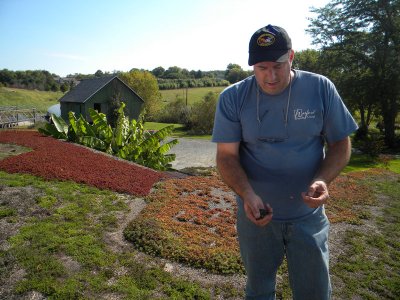
Co-owner John Shepley shows one of the many green roof plants grown on the farm. (Photo by Maryland Newsline's Lindsay Gsell)
By LINDSAY GSELL
STREET (Nov. 27, 2009) - It is a crisp fall day on Emory Knoll Farms as John Shepley stops at a raspberry bush, picks a few berries and pops them into his mouth on his walk to the greenhouses.
He's going to check on the recently assembled plastic covering that will protect the greenhouses in winter. Rows and rows of small sedums, delosperma and other green roof plants sit below, soaking up the sun in their newly insulated home.
These plants have been the sole focus and cash crop of the farm since 1998. Nearly a million of them are grown each year for green roofs around the country, says Shepley, a former electrical engineer who is now co-owner of the business.
The National Aquarium in Baltimore, the Walter Reed Community Center in Washington, D.C., and Radio Shack's World Headquarters in Fort Worth, Texas, are among the farm's more than 400 clients.
The growth of the farm's business—which has seen as much as a 70 percent rise in sales in the last five years, according to co-owner Ed Snodgrass—reflects a growing national interest in green roofs.
Green Roofs for Healthy Cities, a nonprofit working to promote green roofs in North America, reported in a 2008 industry survey that square footage of U.S. roofs covered in greenery had jumped by 36 percent between 2007 and 2008—to 3.2 million square feet.
Since the survey began in 2004, the amount of green roof footage has increased by 123 percent, the group reported.
Green roofs are not only ecologically sound—drastically reducing water runoff—but they can also be beautiful and extend the life of a roof, Snodgrass says.
Shepley says that most green roofs are not installed by people looking for a short-term profit. "Having a green roof is an investment," he says.
Most clients are residential dwellings, school systems, municipalities and government buildings—"people who want their buildings to last longer."
"At lot of developers are beginning to think more long term, he says.
Long-term sustainability is one of the goals that the Friends Community School in College Park had when constructing its new building, which opened in September 2007.
When officials decided to "go green on a budget," says Connie Belfiore, director of admissions and outreach, "we were determined to have a green roof."
Green roof plants weren't always grown on Emory Knoll. When Snodgrass' family began farming Emory Knoll six generations ago, the farm was a dairy farm, he says.
Snodgrass continued with the cows when he took over the farm, but the dairy industry was not profitable for him.
"I went broke dairy farming," he says. "We couldn't control the pricing."
Snodgrass then tried his hand at raising llamas. When llamas didn't work, he began growing perennials.
Through connections in the horticulture world and a few horticulture conferences, Snodgrass learned about green roofs. Fascinated by them, he began growing a small number of plants that were used in research. The business grew rapidly from there, he says.
For Snodgrass, it was clear that green roof plants and Emory Knoll fit.
"I had a lot of faith that green roofs would happen, but didn't envision it being this successful," says Snodgrass, who heads plant research on the farm.
Shepley, who joined the farm as a partner in 2003, says they take pride not only in their service and quality of plants, but on "being a resource for the green world as a whole."
He adds, "We're certainly not perfect, but sustainability guides our decision-making. It guides how our products work."
"Extensive green roofs are made up of a four- to six-inch layer of plants, planting medium and a drainage layer resting on a roofing membrane, which covers a traditional roof.
"They're designed to be both functional and beautiful. Aside from the setup and first few weeks of work, these roofs require little maintenance, says Shepley.
The light, porous covering absorbs water during rainstorms much like a sponge, says Shepley, who manages solar power and watering systems on the farm. For the first 15 minutes of a summer thunderstorm, a building with a green roof will not produce any runoff.
In addition to helping to prevent runoff, the plants help to extend a roof's life. Shepley notes that the two main reasons that standard roofs fail over time is exposure to UV light and sun, and the breakdown of the material from heating and cooling.
That's where green roofs step in. With a less extreme temperature change and coverage from direct sunlight, Shepley estimates that green roofs will last anywhere from 50 to 70 years, double the life of a standard roof.
Not all plants are suitable for life on a green roof. The species must be a persistent ground cover and able to survive periods of drought and extreme heat. To keep maintenance down, the plants have to be long-lived and have a root structure that works with the roofing medium.
It also doesn't hurt if they're pretty.
Green roof plants typically are short perennials and succulents, mostly in the sedum and delosperma families. The sedums—which evolved in a Mediterranean climate—have drought-tolerant capabilities that "blow almost every other plant out of the water," Shepley says.
Sedums are able to close off their pores in the presence of hot, bright sunlight, and at night, open up to put out oxygen and breathe in carbon dioxide.
The green roofs need plants that won't spread their seeds to neighboring soil areas.
"We want plants that'll be good neighbors," Snodgrass says.
Emory Knoll Farms chiefly sells about 30 types of plants, and another 60 to 80 types are sold in small quantities.
In the greenhouse, plants are packed densely in a three-and-a-half-foot tray that holds 72 plants. The plants have roots that are between 3 and 5 inches deep.
Three of these trays can cover 1,000 square feet of standard roof, Shepley says.
Belfiore, of the Friends Community School, says she has been pleased with the impact and symbolism of its green roof.
The roof helps decrease the water runoff into the Chesapeake Bay watershed, she says. Any runoff that isn't absorbed by the roof flows through one of the school's bio-retention ponds, which filter the water before it gets to the bay.
"The green roof we have is working really well," Belfiore says. "It shows to our students and to everybody what we hold important to our philosophy; stewardship of the environment is very important."
^Capital News Service/Maryland Newsline contributed to this report.


